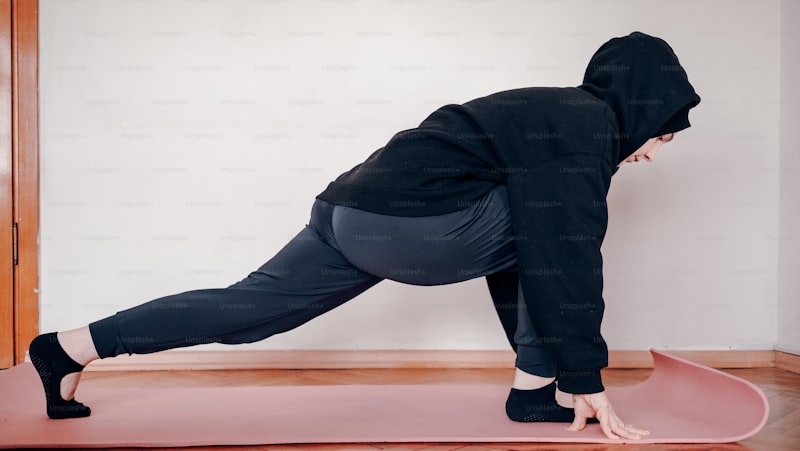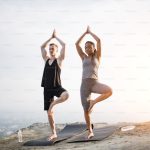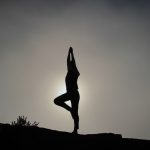Whether stepping forward in sun salutes or used as a hip opener, lunges are wonderfully versatile; lovely and accessible and a great way to strengthen the legs in preparation for other standing poses. Here’s how to really make the most of this simple pose.
The Art of the Lunge
Lunges may not be considered a ‘true’ asana by some but I love them anyway. They can be used in so many ways to stretch, strengthen, open and activate – you can get so much out of one lunge. But what makes a really great lunge?
- Entry — Stepping forward from Down Dog, as in Sun Salutes, or stepping back from tadasana.
- Feet — Both pointing forwards with back heel lifted
- Back leg — Really active with knee straight and glutes activated. Cue pushing back through the heel as if into a wall.
- Front leg — Knee stacked over the ankle with glutes acting to wrap that hip under and prevent that knee drifting inwards
- Chest — Lifted and broad. Cue length through the whole body from back heel to crown of the head.
- Hands — Frame front foot to assist in lifting chest. Flexible students may be able to rise on to fingertips here.
See Also:6 Leg Poses That Are Sure To Leave You Shaking
The Benefits of a Great Lunge
Often considered merely a transition during sun salutes and vinyasa; it is so easy to skip over the teaching points of the lunge on the way to something more exciting. But this is truly short-changing your students. Pausing for a few breaths in a lunge can set solid foundations for more challenging asana later in the class.
- A lunge is a great hip flexor stretch. The stretch you feel on the front of the hip in the back leg is this pose really getting into this hard-to-stretch muscle group. Activating gluteus maximus in the buttock on that leg really helps to gain length in the hip flexors through the magic of reciprocal inhibition – it is often a light-bulb moment when students feel the pose deepen as they switch on their glutes and the flexors relax.
- Lunges are a fab place to think about dual-action too. Aim for length through the whole body as the chest lifts. This helps to prepare the muscles of the legs and spine for more challenging standing poses. Equally, lunges are perfect as the core of the standing sequence of a beginners class.
- There is a world of hip opening going on in a lunge. The front hip works into flexion and abduction and the back one into extension. This helps to lengthen local soft tissues as well as targeting the important fascial connections across the pelvis, up to the torso and down the legs.
And as if all of that wasn’t enough, a really active back leg of a lunge will give a cheeky calf stretch too.
A World of Variety
Though I am an advocate of the simple, straightforward Lunge as a transition or standalone pose, to stop there would be only half the story. The lunge with its modifications and variations offers so much to the discerning yoga teacher. Here are a few of my absolute favourites:
- For the less stable student – Drop the back knee to improve balance and allow a better chest lift.
- Twisted lunge — Place one hand flat on the floor and lift the other high for a lovely spinal twist. This variation really gets into those pelvic fascial connections as well as working on fascial mobility in the arms. The easiest option balance-wise is to lift the arm on the side of the front leg and keep the other one on the floor.
- External rotation of front leg – Turn the toes of the front foot out to feel a stronger stretch in the front hip. Sink the body towards the floor, maybe resting on your forearms – this can do wonders for tight hips, really opening them in preparation for poses like lotus and pigeon.
- Add core work — Lift the arms forwards in line with the body to engage the core. This is great for killer abs or power yoga classes – one of those poses the students love to hate!
I often use these variations in a Sun Salute B style flow pausing in the vinyasa for one or two variants before moving on to the other side. I use them for beginners after a long warm-up as the dynamic phase of a class. And they work just as well as a warm-up for intermediate and advanced classes. I like them personally for morning practice when a full Sun Salute B feels too much for my body and need to practice a little ahimsa and be kind to myself. Lunges really are a pose for all occasions!
I hope I have introduced you to the true magic of this humble pose. Maybe inspired you to use it more. I believe that everyone should have lunges in their life — so lunge on my friends!












